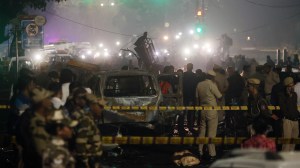Public ills, private cures
February 11: Caught between the granite sheen of a large private medical centre and the grimy mattress in a public hospital, the common man ...

February 11: Caught between the granite sheen of a large private medical centre and the grimy mattress in a public hospital, the common man and woman make their way to the private nursing home next door. Welcome to the world of illegal construction, cut practice, untrained staff and the forced comforts offered by a single doctor enterprise.
Between 1991 and 1994, the number of registered nursing homes in Mumbai has increased from 526 to 1,050. No surveys have been conducted since. There have been no additions to existing public hospitals, and the proliferation of nursing homes continues as young medical graduates convert the kitchens of suburban flats into operation theatres.
“Nearly 75 per cent of health care in India is delivered by the private sector and the share is growing. Public hospital standards have degenerated due to political disinterest, leading to privatisation by default,” explains Dr Santosh Karmarkar, paediatric surgeon at Wadia Children’s Hospital.
Ashwin Sawant, a governmentofficial related his “nightmarish” experience at KEM Hospital a few months ago. “Wards stinking of urine, bedsheets unchanged since two weeks and toilets with broken doors… Asking for new sheets meant trouble – A nurse advised me to“get discharged and find a bed in a private clinic"; which is where Sawant will land up next time.
States Dr Pradnya Pai, dean of KEM hospital,“Public hospitals used to be the first to acquire the latest technology. Now, new gadgets arrive at private hospitals first. The distribution of population in urban and rural India is 70:30 per cent, but the fund allocation is just the opposite.” Except for a private room at almost thrice the cost, Smita Verghese’s experience at a nursing home in Thane was no different, “With no stirrups in the labour room, I delivered my baby with my feet dangling. The nurses were rude and careless.”
Such poor standards can be attributed to the virtual absence of regulations for nursing homes. In order to open a nursing home, theregistration certificate of the doctor and the architectural plan of the hospital are to be submitted at the concerned ward office. The nursing home is registered with no questions asked.
Dr N N Karani, Assistant Health Officer, BMC claims that all nursing homes in the city are inspected by a team of medical officer and sanitary inspectors twice a year. According to Sumita Menon, Junior research officer at CEHAT, a non-government organisation, no standards are specified for nursing homes though the Bombay Nursing Homes Registration Act of 1949 specifies that the BMC should be a supervisory body.
Dr Karmarkar explains the economic limitations of nursing home owners. “Apart from the phenomenal cost of real estate, it takes at least Rs 50 lakh to set up a good operation theatre. The doctor thus tends to cut down on other facilities like a generator, back-up equipment and even trained staff.”
A doctor at J J explains that any surgery, from an appendicitis operation to a complex neurosurgical procedurecosts just Rs 125 at a government hospital. Except for very poor patients, all others should be charged in order to sustain the hospital. At St George’s Hospital, there are 23 paying rooms at Rs 120 per day with an additional Rs 10 per day for food. “Unfortunately, most of them are occupied by an increasing number of MLAs and government officials”says a staff doctor.
Dr Pai suggests a three-tier system in which all minor ailments can be treated at outpatient department outposts: “Patients who basically need to recuperate can be admitted to peripheral hospitals or maternity homes. Highly complex cases like a heart attack could be brought to the main municipal hospital. This will avoid dilution of services.” Another suggestion is of co-operative hospitals with citizens as share-holders. Dr Karmarkar suggests that nursing home owners could be given bank loans at four per cent interest so that the resultant cost of treatment can be controlled.







- 01
- 02
- 03
- 04
- 05
























